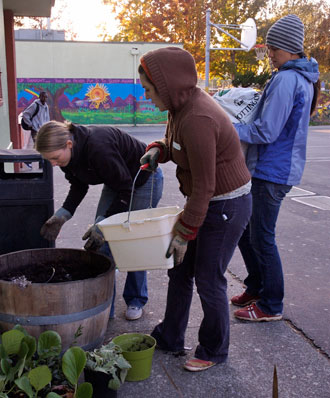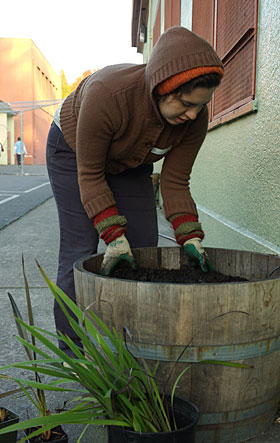Budget crisis prompts LAEP students to take a lesson from the Great Depression
Local schools, parks, and the campus itself benefit from public-works efforts of the 'Landscape Progress Administration'
| 04 December 2009
BERKELEY — There are many ways to skin a state-budget crisis, and in the face of California's, Berkeley landscape architecture and environmental planning students came up with one of their own: a mini-version of the Great Depression's most enduring public-works program.
 Putting their landscaping expertise to work at Oakland's Claremont Middle School are UC Berkeley students (L to R) Kirsten Dahl, Nadia Alquuaadoomi and Nicole Horn. (Carol Ness/NewsCenter photos)
Putting their landscaping expertise to work at Oakland's Claremont Middle School are UC Berkeley students (L to R) Kirsten Dahl, Nadia Alquuaadoomi and Nicole Horn. (Carol Ness/NewsCenter photos)They helped Castlemont High School students build a chicken coop and give their garden a makeover, and they taught Claremont Middle School sixth-graders about watersheds, soil porosity, and garden design. At Mount Diablo State Park, they cut brush and worked on trail restoration.
And on campus, they pulled ivy and other invasive species as part of the Strawberry Creek restoration, provided GIS work for community groups, and audited campus bathrooms to determine how much water they use.
Altogether, some 75 students took part, some for course credit, others not.
"The idea is to do service projects that mitigate some of the impacts on public landscapes due to the state-budget cuts," says Clare O'Reilly, one of six graduate students who coordinated the operation as their term project for Landscape Architecture 242, a course on citizen participation in the planning process. "Most of us are probably going to be working for the public good as landscape architects and environmental planners."
O'Reilly and the rest of the planning cohort — Eustacia Brossart, Hugo Bruley, Kirsten Dahl, Jesse Jones, and Adrienne Smith — all took part in the work as well, and will give a presentation on their project to their LA242 class on Dec. 10.
Naming their project after the Works Progress Administration program of the 1930s, O'Reilly says, was a way of calling attention to the parallels between hard times then and what's going on now, and making a point about the "civic-minded spirit of public investment that we believe is lacking" in the California Legislature in the age of Proposition 13.
The initiative got its start when faculty of the Department of Landscape Architecture and Environmental Planning found themselves talking about the budget cuts at a meeting near the start of the fall semester, according to the students. One of the professors suggested that instead of just complaining about the problem, the department should do something positive.
The students took the ball and ran with it, starting with their town-hall meeting on the first day of classes.
Their first action was to organize a cleanup in their own backyard — the courtyard of Wurster Hall, which houses LAEP. It coincided with the first big campus rally, walkout, and teach-in sparked by the budget cuts, on Sept. 24. About 20 students took part in the cleanup; many more were involved in the walkout, according to the students.
The public-service project was always meant as one more way to respond to the financial crisis and not a critique of the ongoing protests, O'Reilly says, pointing out that "a number of us participated in those as well."
To prepare for their three days of broader community service Dec. 2-4, the coordinators surveyed and interviewed faculty and staff about what their priorities should be. A guiding principle, the students decided collectively, should be that they work in places actually affected by the state-budget crisis: schools, which lost $5.8 billion statewide this year, parks, which have suffered closings because of a $14 million cut (with more to come), and the campus, which is dealing with a $148 million shortfall.
 Nadia Alquuaadoomi gets her hands dirty readying a planter for California native species from Berkeley's Blake garden.
Nadia Alquuaadoomi gets her hands dirty readying a planter for California native species from Berkeley's Blake garden.To get across the idea of watersheds, they had students use aluminum foil to build tabletop topographies, with mountains and valleys. Then, using "rain cups" — plastic cups with dozens of tiny holes in the bottom — they showed how water moves from high places to low. Sprinkling a little dirt on a "mountaintop" and giving it a shower demonstrated the movement of pollution in the environment.
Students also measured how fast water seeped into different kinds of ground — lawn, garden soil, sand, gravel, and woodchips — which tied into a lesson about what happens when the ground is paved: Rainfall can't get in.
The Berkeley students also brought along some California native plants from Berkeley's Blake garden and used them to do a little container landscaping in the asphalt schoolyard.
The future landscape architects and environmental planners who
led the three days of activities learned a few lessons of their own, O'Reilly says.
One was that no matter how far ahead you start, things always need a big push at the end to come together.
"The other was, I've also leaned the value of teamwork," she says. "This wouldn't be possible without everyone working together."
The three-day project may end up spawning an ongoing relationship between Berkeley's LAEP students and the schools and parks that got their help. Come spring semester, the Berkeley student chapter of the American Society of Landscape Architects will be working to figure out long-term partnerships with the schools and parks they worked with — which, like Berkeley, know their budget problems are far from over.

